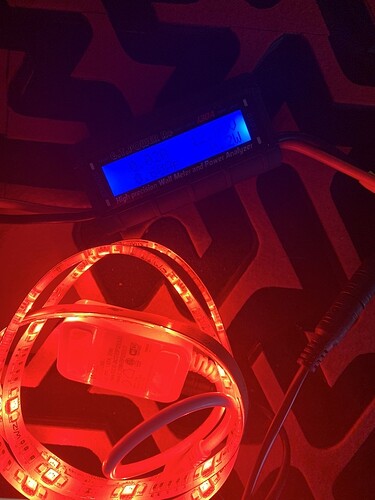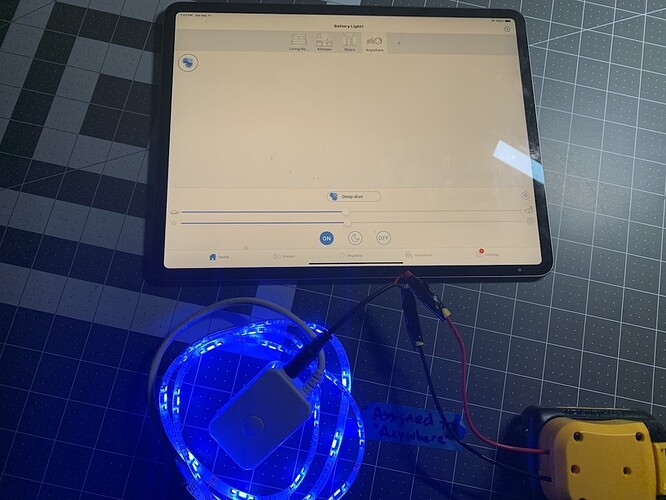Greetings All -
So this was a fun test… I want to run an LED strip light in one of my next projects. But the criteria of what I want is pretty specific -
- Battery Powered
- Easy to swap battery and recharge.
- ‘Smart’ and connected to wifi.
- Fairly small battery / controller
- Stay lit 8-12 hours at moderate brightness.
So, here’s what I came up with.
I use WIZ lights in my home as I like the simple app, I find their quality to be pretty good and consistent, and the app seems to connect to the lights and onboard them to my network easily and quickly every time. No small feat. So, I chose the 3.3 foot strip at it should be sufficiently bright and an adequate length.
Oh, and I also chose WIZ for this project as their controller uses a wall wart, of course, and the output is 12v dc. So, what batteries do I have on hand that are 12v, easily / quickly rechargeable and easy to adapt to a power plug with an adapter? ![]()
Go with what you know. So I decided to also try this “High precision Watt Meter and Power Analyzer”. Just to get an idea of the volts and watts being used, and to estimate the runtime. I hooked up the analyzer to the freshly charged battery and confirmed, 12.12 volts.
Next up, connect everything else - Battery to watt meter, meter to light controller and sync to the WIZ App. The default light output level is ‘Wam White/Full brightness’. It works, but what’s the watts?
I did all the math, of course, based on the rated power output of the wall wart and the maximum claimed strips you can use on one kit. All very boring, to most people. So here’s the pic. With a light output of Warm White, full brightness, the meter says it was using 3.2watts.
Ok, so do the math - 3.2w/12v=.27ah divided into the 1.3Ah rating on the battery, and it should run about 4.8 hours. Short of my 8-12hour goal, but, I don’t want Warm White and don’t need full brightness. So, lets try some other colored light. Green at half brightness = 0 watts? Seriously…
Ya, the meter is clearly having some difficulties, probably with the power factor of the lights. But that’s a whole different discussion, and borefest… So how about red at half brightness?
Seriously, .2watts. Ya, that’s not right either.
Ok, scratch that idea. I’m just guessing, based on the perceived brightness, that the strip is probably using 1-2watts, and the electronics are minimal. So let’s just try this thing. I’ll do the color and brightness I think I want and just let it run on a stopwatch. Here we go, Deep Dive (Blue) and 50% brightness.
Well, over 9 hours later, it’s still going. But, as you can see, the battery is down to 10.5volts. And interestingly, the controller was still reachable on the network so that’s cool. The light was dimmer than at the start, but still sufficiently bright. So I would call this experiment a success.
Just to confirm, If the battery is 1.3Ah x 12v = 15.5 Watt Hours / 9.3 hours = 1.66 watts (average). Clearly it started out using more watts (brighter) and as the battery voltage went down, so did the brightness and the wattage used. So I think my initial estimate of 1-2watts is in the ballpark, and it doesn’t really matter as I know the LED strip will work as long as I need it to, regardless.
On a side note - I also tried to run it until totally dead… I used red on half brightness and let it run overnight. After about 13 hours the lights were still on and only a fair amount dimmer. I checked the battery voltage and it was down to 8.5v. That would normally be doomsville for traditional battery’s, and could be damaging the lithium one as well. But shortly thereafter it did go out. Could have been the battery, or the controller could have cut off too.
I put the battery in the charger and the charger didn’t recognize it was there… Doomsville? I let it sit in the charger 5-10 minutes, took it out and plugged it back in and it registered this time and started to charge. So the experiment didn’t totally kill it. When it was charged I remeasured the voltage and it showed 12.06, so maybe I took some years off it’s life, but hard to tell.
For the real project I’ll solder a decent barrel connector directly into the battery adapter to be much more tidy.
On a super side note. In the WIZ app you have to choose a ‘Room Type’ for light when you connect it. There’s no assumption that it could be portable. That’s short sighted. ![]()
But you can give it a custom ‘location’ name, although you are stuck with the supplied icons. So it’s located ‘Anywhere’. Seemed accurate.
With that, we’ll call it a wrap…
HL

















